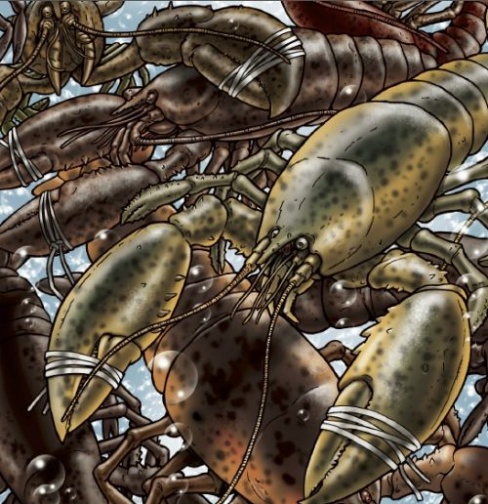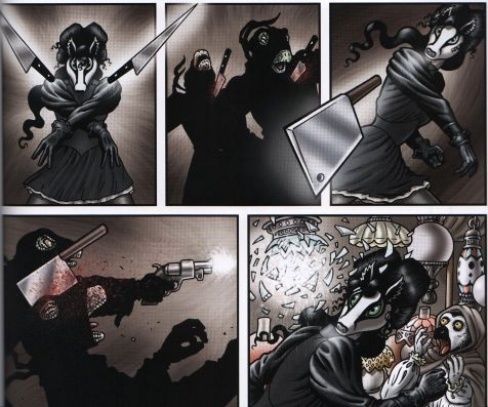The latest in the ambitious series of anthropomorphic steampunk graphic novels is another fine showcase for Bryan Talbot’s talents as an artist and a world-builder; but despite being as joyful to read as any previews Inspector LeBrock adventure, there’s a lack of thematic effort which make this book feels somewhat shallow by comparison. By focusing more on sly references and the closing of previously established plotlines, this swansong that never quite reaches the heights of previous of efforts.
Written, illustrated, and lettered by Bryan TalbotCover by Bryan Talbot
Colored by Bryan Talbot, with Alwyn Talbot, Angues McKie and Jordan
SmithWanted for murder and on the run, Detective Inspector LeBrock is the victim of a diabolical scheme engineered by gangland overlord Tiberius Koenig. But LeBrock is a fighter, and now against insurmountable odds, the British Badger risks all to thwart Koenig’s plot and save queen, country, and all he loves!
“There he goes, will we ever see his like again?”
– The last words of Inspector Ratzi
If there’s one thing that the “Grandville” does well, it is defying expectations. The idea of anthropomorphic animals playing detectives in with lush historical background seems to point in one direction – noir dolled up in feathers and scales – but Bryan Talbot gives us something that is both weirder and richer. He gives it a complex alternate history the explores ideas of revolution, religion and human rights.
In the world of this series France had a far more successful run during the Napoleonic era, including the complete conquest and subjugation of England. The empire (whose capital is Paris, aka Grandville) is only recently on the wan following a successful British resistance campaign. These details, and many others, are doled out throughout the various volumes and give a sense of a unique and truly thought-out world. Likewise, the anthropomorphic aspect is not simply a matter of dressing out people in animal features. Indeed, there are regular humans in this world whose existence becomes the focal point of the third volume. Whenever we think we know what Talbot is doing, he throws another twist our way.
This fifth and final volume begins in similarly interesting manner: showing us regular lobsters in a tank, claws bound in rubber, about to be boiled and consumed by the impeccably dressed hungry patrons who are themselves sea beasts of various sorts (the establishment is owned by a Crayfish mobster). The rich and powerful prey upon the weak, who cannot defend themselves, and even in a post-revolution society class seeks to re-establish itself. It’s a great visual, brought to life by sharply detailed pencils and implacable color work. You can feel the air crackling with the anticipation of violence, lobsters are about to be cracked and eaten, only for it to occur in an unexpected manner as the restaurant becomes the victim a drive-by shooting. A the page becomes a dance macabre of bullets and blood, the predators become themselves prey. Unfortunately, after this powerful scene the book forgoes any moral complexity or attempt to deal with subjects outside the fictional reality and becomes a rather orthodox, if effective, detective story.

One of the critiques Alan Moore had for his work on “The Killing Joke” was that it was, eventually, a book about nothing other than the fictional being of Batman and the Joker – it had no relevance to the world the reader inhabits. From the beginning, Talbot made sure that “Grandville” was never simply about its own being; every book had a subject that went beyond the mystery story de riguer. The post-revolutionary setting allowed Talbot to use the plots to engage with subjects such as class warfare, historical revisionism and civil rights struggles. It wasn’t always the most successful of attempts – there’s something odd about a civil rights struggle in which the persecuted minority is composed of white people – but it was always an attempt to engage with the world of the reader.
In “Force Majeure,” there is no such attempt. The plot sees LeBrock go head to head with his own version of Sherlock Holmes’s Moriarty in a long game of cons and counter-cons. Moriarty, famously, was only introduced so that Sir Arthur Conan Doyle could get rid of Holmes, and this story’s chief gangster is not that much more interesting. He’s more of a plot mechanic than a proper character.
Continued belowThe villain also brings to light the problem with LeBrock’s character faults: namely, he has none. LeBrock is as smart as he is strong, supremely knowledgeable in all relevant fields, and surrounding either by adoring sidekicks or bumbling superiors. In previous volumes, his qualities were more balanced out by his uneven temper which often led him astray, but in “Force Majeure” he is always three steps ahead, which neutralizes any sense of danger. It’s the type of story that eventually boils down to two opponents sitting in front of a metaphorical chess board announcing to reader how they planned all their moves and counter moves weeks in advance, only for one to announce that he actually won before the game even started because they were playing backgammon all along. It rather takes the sting out of the “thrill” part of this self-described “scientific-romance thriller.”
Still, for all its faults “Force Majeure” remains a delightful read. A lot of it is down for Talbot’s skill as an artist, not simply in the technical skill (though he is a superb craftsman), but in the way he paces and builds up the page. So many scenes in “Force Majeure” are heavy in details, backgrounds, characters, words and events but the pages never feel busy. Talbot creates a world that feels rich but not overpowering. Even as the book reaches its denouement, with a long speech explaining all the twists and turns of the mystery, there’s some clever use of cutting to keep the scene moving. It’s a very talk-y book, as needs be for a complex mystery, but it never feels overtly so.

It’s as lovely to look at as any previous “Grandville” story; there are some spectacularly choreographed action scenes that make clever use of scenery and environment, like when Billy escapes assassins through the crowded streets of Grandville. These moments are satisfyingly bloody without becoming unnecessarily gruesome, with the exception of a single part involving the tiresome trope of torturing the love interest to motivate the hero. Likewise, Talbot keeps every panel interesting to look at by filling the background with dozens of tiny jokes and homages to previous heroes of detective and anthropomorphic fiction. You can sense the amount labor that went into every image; like “League of Extraordinary Gentlemen,” this is the type of comics that calls for future annotations, but thankfuly these details remain on the side, a little thrill to those who notice them, without ever overtaking the main story.
“Force Majeure” may be the least of the “Grandville” tales – but the least of “Grandville” is still head of the pack.




